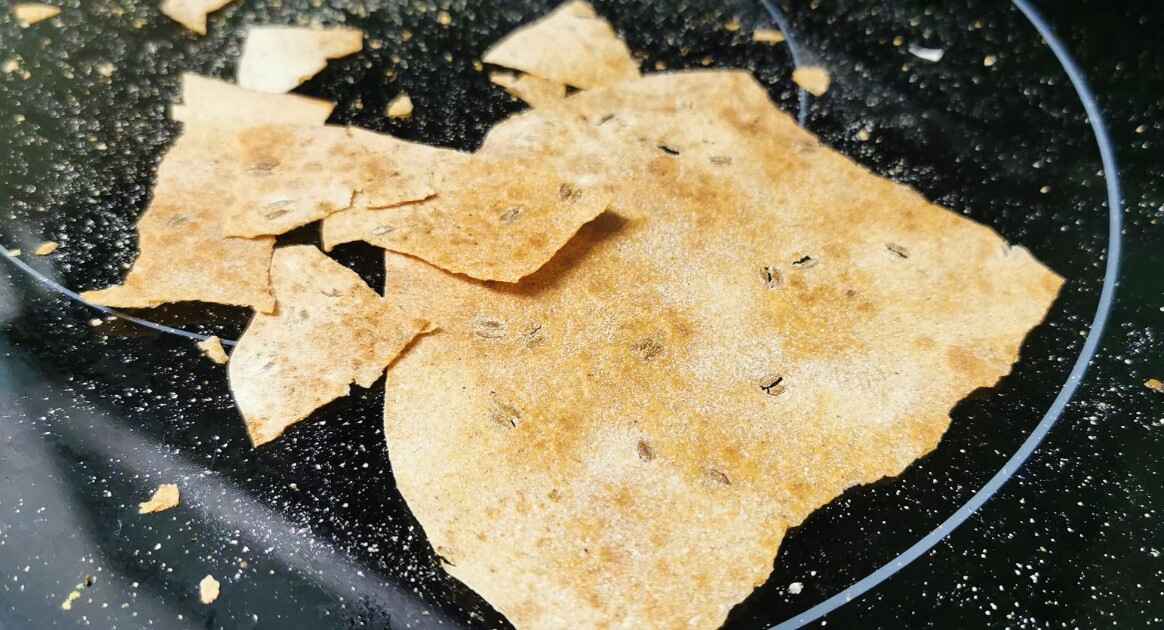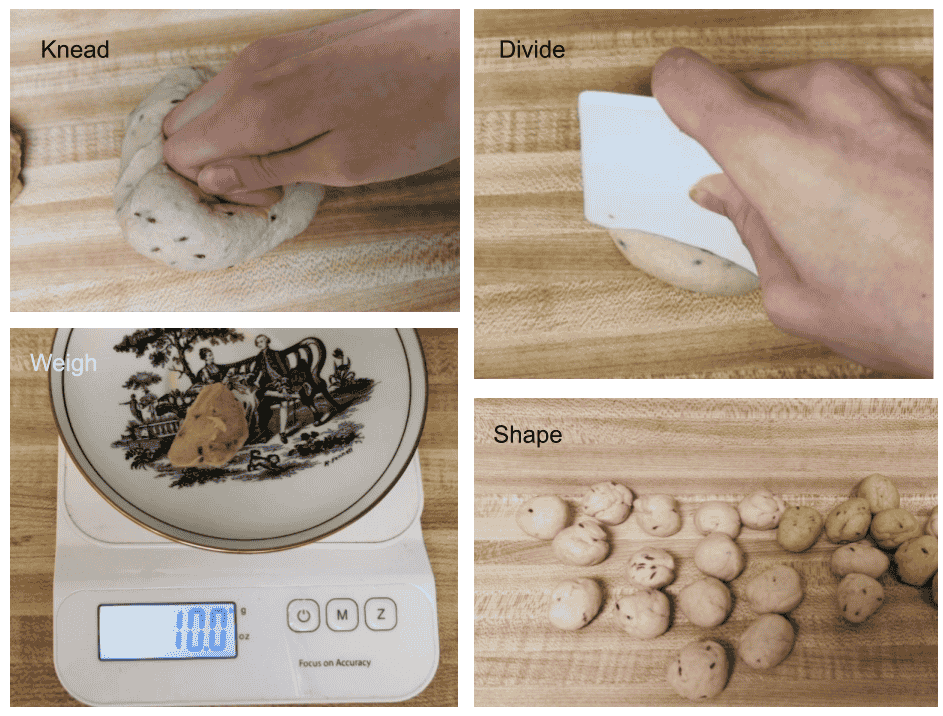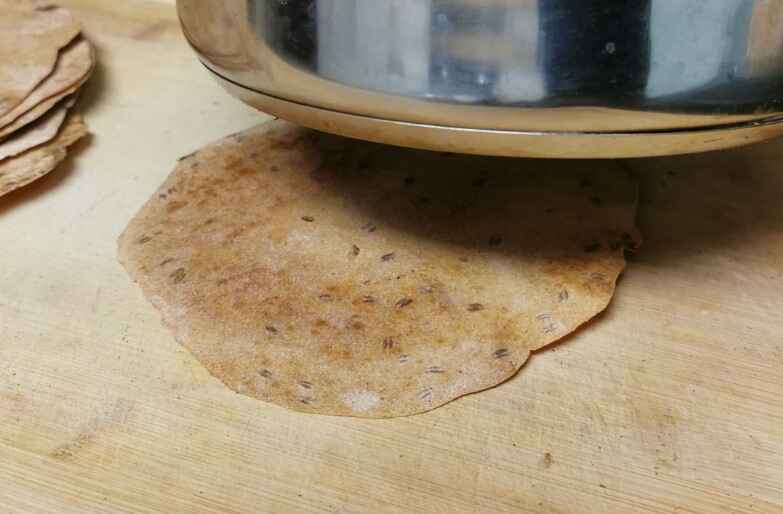



If you search for "khakhra recipe", you will find, as I did, that the classic way to cook khakhras at home is to press and turn them on your tawa or pan with a cotton cloth.
This method essentially roasts the khakhras like a roti with a little bit of oil until they dry all the way out to become cracker-like. Roti crackers. Yum?
The resulting "khakhra" is then dry and snaps like... well... dried out roti. Not very apetizing in my opinion and certainly not the classic khakhra experience.
Khakhras need that signature flakey, crumble crunch; like a buttery cookie.
Being dissatisfyed with my homemade-khakhra findings, I then did what every determined chef does and looked for how khakhras are mass-produced. What are the industrial methods?
I found that the biggest difference in the industrial process from homemade way was the cooking method.
The dough was simple enough, the rolling/squashing was similar, but the cooking... The cooking was different.
When making khakhras commercially, each khakhra is pressed between two hot, cooking surfaces under pressure and stays there until it is fully cooked.
Pressure roasting...
Like this:

You can see an example of commercial khakhra making here:
To replicate a similar process, I started using pot.
I mean A POT.
Basically, you just cook the khakhras like any normal person would on a tawa or comal, except instead of pressing them with a cotton cloth, press them with the bottom of a pot.
The pot should be the same diameter as the khakhras or wider.
Like this:

There is a khakhra under this pot, I promise.
I know you can't see it, but it's there. Just feel it's presence in the spirit ok? Have some faith, jeez.
In cooking, people tend to spend all of their time worrying about the exact right ingredients which I find morally infuriating.
While exactly-right ingredients do make a difference and do HELP in most cases, ingredients alone never made a roti.
Process is a very important and far too often overlooked factor of any recipe.
All rants aside, this is my take on why this cooking process works:
!!Theory Alert!!
"Pressure roasting" the khakhra as it cooks, traps in the steam at the same time as ensuring constant contact with the hot surface of the pan.
The result is similar to that of deepfrying.
I don't feel like explaining it any furthur than that. It works, ok? Just idk im tired, and if you've read this far im sure u are too.
Just go make the khakhras already.

◆ 1.5 cups Atta Flour
◆ 3 tbsp Cooking Oil (I use olive oil -you can't tase the oliveyness)
◆ 1/2 tsp Salt
◆ 1/3~ cup Water (Add until you have a stiff dough)
◆ 2 tsp Cumin seeds
(for every one cup flour)
◆ 2 tsp Cumin Seeds
◆ 1.5 tsp Coriander
◆ 1.5 tsp Chile Powder
(for every one cup flour)
◆ 1/4 tsp Cinnamon
(for every one cup flour)
In a dough-mixing vessel of your choice (a bowl), put:
◆ 1 cup Atta Flour
◆ 1.5 tbsp Cooking Oil
◆ 1/2 tsp Salt
Mix this all together really well, and crumble the oil into the flour.

Once these ingredients are mixed together, add in your khakhra flavoring.
If you decide to make two flavors, divide the flour mix in half and add half of the respective flavoring seasonings.
For this recipe, I will be making, half Jeera (Cumin) and half Masala.
Once you have divided the flour mix(es) and crumbled in the flavor seasonings, add your water.
Meausure out:
◆ 1/3~ cup Water
Begin with adding a little bit at a time to the flour mix.
Slowly mix the water into the dough, kneading with your knuckles as you go along.
I don't have the exact measurement of water, so you're just going to have to conjure up your inner angel-chef skills and wing it.

You want to err on the side of LESS water. Stiff dough is ok -soft dough is really difficult to roll out to be super thin.
Watch the video for a better idea of the final dough texture.
Knead the rested dough for about 10 seconds.
Then, using a bench scraper or any other creative means you can think of, divide the dough into 10-gram pieces.
As seen in the image, I use a kitchen scale to get the pieces exactly the same size.

Once the dough has been divided, shape each 10-gram piece into a nice little ball, ready to roll out.
Bro, what even is this picture on the plate anyway?

Pretty sus ngl.

I digress.
Have a little plate or bowl of plain atta flour ready to use for rolling out khakhras.
Take a little dough ball, toss it in the flour, spread some flour on your rolling surface and then just begin rolling.

Stack your rolled-out khakhras to the side as shown in the pic. (They don't stick to eachother, the dough is too dry for that.)
I use an annoying western-style pastry/pie rolling pin AS OF RIGHT NOW, but I woud suggest using a nice Indian-style rolling pin (belan) if at all possible, as it will make it easier to roll the khakhras thinner.
I usually put my comal or tawa (pan) on the stove to heat up a few minutes before I am done rolling out the khakhras.
FIRST Turn your burner on medium or below medium heat.
Khakhras cook best on lower temperatures, where they slowly roast instead of cooking like a roti.
SECOND Once your pan is hot enough to cook the dough and not just dry it out, begin pre-cooking the rolled out khakhras.
Put each khakhra on the tawa and let it sit for about 10 seconds or until the dough color darkens slightly, indicating that the flours are cooked.
Flip the khakhra and cook it briefly for about five seconds and then remove it immediately.
NOTE: Adjust the temperature during this stage of the cooking. Make sure that NO brown spots appear on the khakhras. If brown (cooked) spots appear, turn the heat down.
THIRD Place the pre-cooked khakhra underneath a lid or plate to trap in moisture as it cools down so as to ensure that it does not dry out.
Once you have a nice stack of pre-cooked khakhras, you are ready to begin the final step of pressure roasting them.

FIRST Take a khakhra from the stack of pre-cooked khakhras and drizzle about 1/3 tsp of oil on one side.

SECOND Place the oiled khakhra oil-side-down on your pan.

THIRD Place a pot ontop of the khakhra, press, and hold, consistently applying about 4kg of pressure.
As it cooks, move and flip the khakhra, pressing it each time for about 15 seconds.
The khakhra might squeel and hiss as the compressed steam realeases. Don't freak out.
In about one minute, the khakhra should be golden brown and nicely crisped up.
WARNING: The moist dough under pressure does create some hot steam. It isn't really dangerous at all, it can just be uncomfortable if the steam hits your skin so, keep your arms and hands clear of it.

FOURTH Remove the khakhra once cooked and place it on a wooden surface (to avoid condensation making the khakhra soggy).
While I oil and prepare another khakhra, I set the pressing pot ontop of the freshly cooked khakhra to iron it flat. (they can tend to warp and curl as they initially cool)



